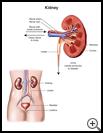
Pyelonephritis Discharge Information
What is pyelonephritis?
Pyelonephritis is a bacterial infection that can affect one or both of the kidneys. It usually starts in the urethra, which is the tube that empties urine from the bladder, or in the bladder itself. The bacteria travel up to the kidneys from the bladder. Bacteria can also reach the kidneys from an infection somewhere else in the body.
Pyelonephritis can be serious because it can permanently damage the kidneys and the infection may enter the bloodstream.
How can I take care of myself when I go home?
How long it takes to get better depends on how severe your symptoms are when you start treatment. In mild cases, you will start feeling better in the first 1 or 2 days. It may take several days if you have a more severe infection. With proper treatment, there are few complications of a kidney infection.
Management
- Your provider will give you a list of your medicines when you leave the hospital.
- Know your medicines. Know what they look like, how much you should take each time, how often you should take them, and why you take each one.
- Take your medicines exactly as your provider tells you to.
- Carry a list of your medicines in your wallet or purse. Include any nonprescription medicines and supplements on the list.
- Talk to your provider before you use any other medicines, including nonprescription medicines.
- Your provider may prescribe medicine to:
- Treat pain
- Treat the infection or prevent future kidney infections
- Treat nausea or other symptoms caused by the kidney infection
- Your provider may recommend other types of therapy to help relieve pain, other symptoms, or side effects of treatment.
- Follow activity restrictions, such as not driving or operating machinery, as recommended by your healthcare provider or pharmacist, especially if you are taking pain medicines.
- Drink enough fluids to keep your urine light yellow in color, unless you are told to limit fluids.
- The best way to prevent kidney infections is to try to prevent bladder infections. Women can take the following steps to try to prevent bladder infections:
- Practice good hygiene when you use the toilet, such as wiping from front to back.
- Avoid using irritating cosmetics or chemicals in the area of the vagina and urethra, such as strong soaps, scented sanitary napkins.
- Urinate to empty your bladder after you have sex.
- Men can take the following steps to try to prevent bladder infections:
- Practice good genital hygiene. If uncircumcised, gently pull back the foreskin when washing the penis.
- Urinate to empty your bladder after you have sex.
- Ask your healthcare provider if there are any foods or medicines you should avoid.
- Take care of your health. Try to get at least 7 to 9 hours of sleep each night. Eat a healthy diet and try to keep a healthy weight. If you smoke, try to quit. If you want to drink alcohol, ask your healthcare provider how much is safe for you to drink. Learn ways to manage stress. Exercise according to your healthcare provider's instructions.
Appointments
- Follow your provider's instructions for follow-up appointments.
- Keep appointments for any testing you may need.
Talk with your provider about any questions or concerns you have.
Call your healthcare provider if you have new or worsening:
- Back or belly pain
- Loss of appetite
- Nausea or vomiting
- Increased urination
- Pain or burning with urination
- Urgent need to urinate often
- Blood in your urine
- Signs of infection around your surgical wound if you had surgery. These include:
- The area around your wound is more red or painful
- The wound area is very warm to touch
- You have blood, pus, or other fluid coming from your wound area
- You have a fever higher than 101.5° F (38.6° C)
- You have chills or muscle aches
Last modified: 2015-04-16
Last reviewed: 2015-12-21


